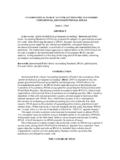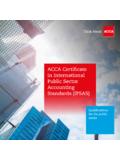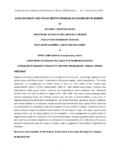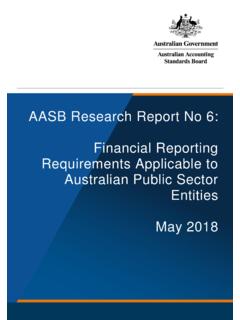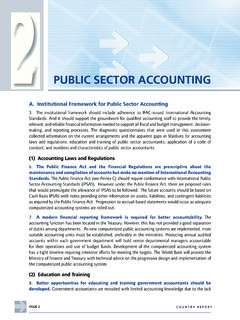Transcription of Financial position of public-sector institutions
1 97 8 Financial position of public - sector institutions In brief The net asset position of state-owned companies stood at billion in 2014/15. Average return on equity declined to per cent. These companies project total capital spending of billion over the medium term, with borrowing reaching R257 billion. Development finance institutions expect to lend billion by 2017/18. While the overall position of social security funds remains strong, their combined net asset value will decline to billion as a result of the rising deficit in the Road Accident Fund. Government is enacting a series of reforms to improve operations, Financial management and governance of public - sector institutions . Greater private- sector participation will be considered. Overview he National Development Plan (NDP) recognises the important role of public - sector institutions in economic growth and development.
2 State-owned companies, development finance institutions , social security funds and the Government Employees Pension Fund provide essential services, finance infrastructure investment, and contribute to job creation and the social safety net. State-owned companies build and maintain electricity, water, transport and telecommunications infrastructure. Development finance institutions fund infrastructure expansion, industrial development, commercial and emerging agriculture, and improve access to housing and small business loans. Social security funds and the Government Employees Pension Fund compensate people who are out of work or injured, support a savings culture and promote investments that have a social impact. During 2014/15, Eskom electrified 159 853 households and supplied 216 274 GWh of electricity. Transnet transported million tons of freight by rail.
3 Development Bank of Southern Africa (DBSA) involvement in municipal funding resulted in 90 000, 56 000 and 138 000 households benefiting from energy, water and sanitation public - sector institutions play an important role in realising vision of National Development Plan T Entities provide electricity, rail transport, water and sanitation and create jobs 2016 BUDGET REVIEW 98 projects respectively. DBSA assistance also contributed to the completion of 15 schools and supported 754 small and medium-sized enterprises. Industrial Development Corporation (IDC) projects created an estimated 8 223 jobs. Joint initiatives by the IDC and Unemployment Insurance Fund (UIF) helped to preserve 44 460 at-risk jobs. To deliver on their developmental priorities, public - sector institutions need to be in a sound Financial position .
4 Generating a reasonable rate of return allows them to operate independently of the national budget. Deterioration in the Financial health of these entities is often an early-warning sign of broader strategic challenges, and can have major consequences for the public finances. Accordingly, government monitors their operations and Financial positions, managing risk and taking action when required. Over the past several years, poor global and domestic economic conditions have contributed to declining profitability of some institutions , while others have still performed well. However, internal weaknesses such as inefficient operations, poor governance and weak balance sheets have made some entities more vulnerable to a deteriorating economic outlook. Several public institutions continue to pose significant short-term risks to the fiscus.
5 In some cases, this is due to large government exposures; in others, to the entity s poor Financial position . Although no requests for fiscal support are currently being considered, the assessment of any such requests will be informed by the principles set out in the 2015 Budget Review, namely: Any intervention to support state-owned companies must be consistent with sustainable public finances. Capitalisation cannot have an impact on the budget deficit. Entities receiving support are required to demonstrate sound business plans, improve governance and address operational efficiencies. Future commitments of state resources to support public - sector institutions will also depend on reforms that resolve ongoing problems with governance, and may also involve introducing private- sector participation. Reforming public - sector institutions A series of reforms under way is intended to strengthen the ability of public - sector institutions to support NDP outcomes.
6 These reforms are based on the recommendations of the Presidential Review Committee on State-owned Entities. The committee s recommendations include a single governing law for public entities; rationalising the number of entities; and mobilising co-investment and technical expertise from the private sector to strengthen their Financial and managerial capacity. The outcome of these reforms will be a clear policy setting out the criteria for state ownership, and a streamlined portfolio of public entities that builds on synergies between the public and private sectors. An inter-ministerial committee chaired by the deputy president is overseeing implementation of four broad areas of reform: Stabilisation to improve near-term Financial and operational performance. A framework to quantify the cost of developmental activities has also been developed.
7 Most entities are expected to be self-sustaining and operate independently of the budget Further state support will be contingent on reforms that resolve ongoing governance and operational problems Private- sector co-investment to strengthen Financial and managerial capacity at public entities CHAPTER 8: Financial position OF public - sector institutions 99 Coordination and collaboration to maximise contributions to the economy and eliminate duplication. Joint infrastructure projects are already taking place in the energy, transport, mining and water sectors. Rationalisation and consolidation to reduce state participation in sectors where several entities operate with overlapping mandates. This is already under way in the information and communication technology sector with the rationalisation of Broadband Infraco. The state intends to dispose of holdings in non-strategic assets, as needed, to direct resources to areas critical for development Governance framework will see the enactment of overarching legislation, informed by a review of the current shareholder management model.
8 Board appointment processes will be standardised, and remuneration frameworks reviewed to ensure that compensation growth is contained and linked to efficient performance. Government is developing a framework to encourage greater co-investment and participation by the private sector in partnership with public entities, building on the success of the independent power producer initiative. The framework will support increased levels of competition within well-regulated sectors. Historically, the South African economy has been characterised by high levels of economic concentration, with many state-owned companies enjoying a monopoly or dominance of the sectors in which they operate. Allowing competition would improve efficiency and increase investment levels, entrepreneurship and employment. Financial overview Table shows the combined Financial position of public institutions .
9 Table Combined Financial position of selected categories of public institutions , 2012/13 2014/15R billion2012/132013/142014/15 State-owned companiesTotal 1 Total Net asset Development finance institutions1 Total Total Net asset Social security fundsTotal Total Net asset value Other public entities2 Total Total Net asset 1. institutions listed in schedule 2, 3A and 3B of the PFMA2. State-owned institutions without a commercial mandate and listed in either schedule 1 or 3 of the PFMA such as the National Library of South AfricaSource: National TreasuryNew framework will support increased levels of competition within well-regulated sectors 2016 BUDGET REVIEW 100 At a consolidated level, the Financial position of public entities strengthened in 2014/15 the most recent period for which audited results are available.
10 Most categories of institutions continue to improve their net asset position largely as a result of capital investments by state-owned companies since 2010/11. The decline in the net asset position of development finance institutions resulted from losses on the Industrial Development Corporation s equity portfolio, which was exposed to the commodities sector . State-owned companies State-owned companies have spent an aggregate billion on infrastructure since 2010/11. Most of these investments have been in the energy, transport and logistics sectors. Over the next three years, investment in these sectors will continue to dominate capital formation by the public sector . Over the medium-term expenditure framework (MTEF) period, state-owned companies project capital expenditure of billion, with Eskom, Transnet and the South African National Roads Agency Limited (SANRAL) accounting for 94 per cent of this amount.











